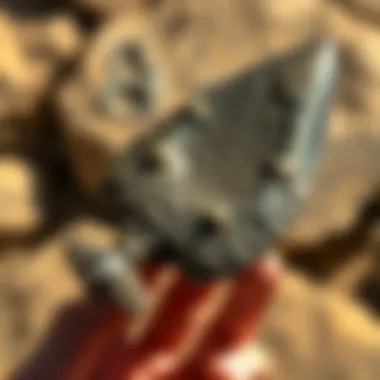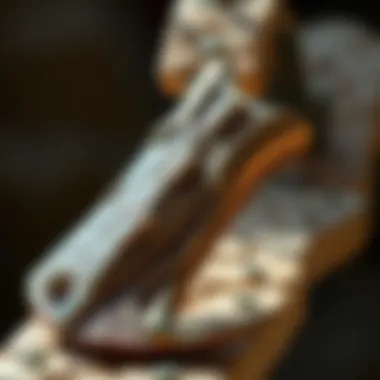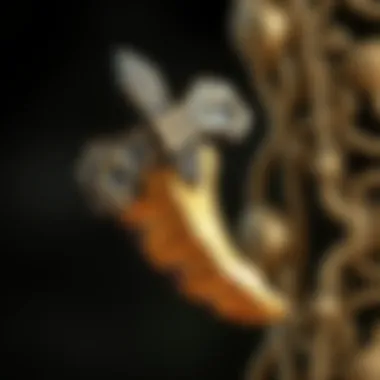The Handaxe: Significance in Human Evolution


Intro
The handaxe stands as a cornerstone in the story of human innovation. Long before the rise of complex civilizations, these tools were instrumental in the daily lives of our early ancestors. Crafted primarily from flint or other sturdy materials, handaxes served multiple purposes: from cutting meat to fashioning wooden spear points. They were a leap forward in human ingenuity, marking a significant step in the transition from simple tool usage to more sophisticated manufacturing methods.
Understanding the handaxe involves delving into various aspects such as its historical relevance, the evolution of its design, and its influence on cultural practices in early societies. Each handaxe serves as a testimony to the skills and creativity of its maker. After all, a tool can tell a story, revealing the needs and challenges faced by those who created it. Cultural contexts, along with archaeological findings, help contextualize the handaxe within the broader scope of human history.
In this exploration, we will take a closer look at the significant variations of the handaxe across different regions, how these tools reflected the environments in which they were used, and their impact on future technological developments. This narrative will not only enhance our understanding of the tool itself but also enrich our appreciation of the early human experience, marking each handaxe as a symbol of adaptability and survival. Let's set the stage for this journey through time.
Preface to the Handaxe
The handaxe stands as a crucial piece of technology in our human story, framing a narrative that stretches back hundreds of thousands of years. It serves not only as a tool in prehistory but also as a lens through which we can examine the evolution of human ingenuity. The handaxe is one of the earliest examples that showcases our ancestors’ ability to manipulate their environment with purpose and efficiency.
Understanding the handaxe’s significance involves more than just grasping its physical characteristics. It delves deep into what the handaxe represents—adaptation, survival, and the burgeoning intellect of hominins. Each handaxe found in archaeological digs is a testament to human creativity, showcasing different styles, materials, and functions that are deeply rooted in the culture of the time.
Benefits of Studying the Handaxe
- Technological Advancement: It reveals the shift from mere survival to more complex societal development.
- Cultural Insight: Each design variation indicates distinct cultural practices and environmental adaptations.
- Evolutionary Milestones: Understanding the handaxe helps underscore significant phases in human evolution.
The exploration into the handaxe is like peeling back layers of history, one stone at a time. It allows enthusiasts, especially those within the fossil and rock collecting communities, to appreciate not only the form but also the function—the stories that these artifacts encapsulate.
This groundwork sets the stage for a comprehensive understanding of the handaxe, paving the way for a broader investigation into its history and significance in shaping human societies as we know them.
The legacy of the handaxe is not just about the tool itself but the innovations it spurred in human behavior and society.
With this foundational knowledge, let’s delve deeper into what constitutes a handaxe, highlighting its defining features and tracing its historical journey.
Archaeological Context
The archaeological context of the handaxe is a critical aspect that allows us to grasp its full significance in human history. It acts like a keyhole through which we can peek into the lives of our ancestors. Understanding where these tools were found and how they relate to other artifacts can shed light on early human behaviors, migration patterns, and technological advancements.
Sites of Discovery
Handaxes have been unearthed in various locations around the globe, each site contributing unique insights into human evolution. Some of the most notable sites include:
- Olduvai Gorge, Tanzania: Known as the cradle of mankind, the findings here hint at the early use of handaxes as essential tools for survival. The stratified layers of this site allow archaeologists to discern significant shifts in tool technology over time.
- The Thames River, England: The riverbanks have yielded handaxes dating back over half a million years. The proximity to ancient waterways suggests that early humans were adept at utilizing local resources effectively.
- La Cotte de Saint Brelade, Jersey: This site reveals handaxe usage alongside evidence of large game hunting. Here, the handaxe served not just as a tool, but as a symbol of social collaboration among groups.
These sites are more than just geographical coordinates; they represent chapters in a rich narrative of human adaptation and ingenuity. As researchers delve deeper into these locations, they uncover stories that may have otherwise remained buried.
Dating Techniques and Findings
The dating of handaxes poses both challenges and opportunities for archaeologists. Various techniques have been employed to ascertain their age, with results painting a canvas of human development that spans millennia. Some of the most utilized methods include:
- Radiocarbon Dating: Though primarily applicable to organic materials, this method can be paired with handaxes found in contexts containing plant residues.
- Thermoluminescence: This technique helps date the last time pottery or flint was heated, offering insights into when handaxes were potentially created or utilized.
- Stratigraphy: By examining the layers of soil in which handaxes are discovered, archaeologists can establish a relative timeline for various stone tools and their relationships to other artifacts and fossils.
The findings from these dating techniques not only confirm the antiquity of handaxes but also highlight their evolutionary significance. For instance, the age of certain handaxes has been linked to significant climatic events, further establishing their role as tools of resilience in shifting environments.
Understanding the archaeological context of the handaxe not only uncovers its functionality but also hints at the cultural and social frameworks of early human societies.
Through a thorough examination of sites and precise dating strategies, the story of the handaxe and its importance in the tapestry of human evolution becomes clearer. As we continue to study these fascinating artifacts, their role as markers of human progress will only grow in significance.
Design and Variations
The design and variations of the handaxe play a crucial role in understanding its functionality and cultural significance throughout human history. By examining the morphological characteristics and regional differences, we can gain insight into how early humans adapted tools to their local environments and needs. These aspects also shine a light on the remarkable ingenuity and creativity of our ancestors, which framed their survival and progress in diverse habitats.


Morphological Characteristics
Morphological characteristics of handaxes can be quite enlightening. These tools, often made of flint or stone, typically exhibit a consistent teardrop shape. This particular form could be attributed to the dual functional aspects; consumers could use them for cutting and scraping, which offers great advantages in various tasks. The edge's sharpness, the tool's overall weight, and the balance of the handaxe are key features that indicate the skill of the creator.
Handaxes usually possess a pointed end that aid in piercing, while the broader side allows for efficient slicing or processing of materials. Moreover, the quality of the flaking is vital; superior handaxes often feature fine, controlled flakes, a result of skilled knapping. These traits are not mere aesthetic choices; they reflect the thought processes behind tool creation aimed at practical usefulness.
Regional Variations
The diverse regional variations of handaxes highlight the cultural and environmental adaptations of humankind. Different geographical locations produced distinct styles of handaxes, often influenced by the local materials available and the specific needs of the societies using them.
European Handaxes
The European handaxes are often characterized by their symmetrical teardrop shape with a fine finish. These tools indicate a high level of crafting skill and precision. The presence of Acheulean technology across Europe showcases a timeline of tool production that spans thousands of years. This design reflects the diverse environments because it was an efficient tool for thriving in a multitude of ecological niches, from the cold forests to open plains.
A key feature is their variation in size; some are quite large, allowing for heftier tasks, while others are smaller and more portable. Larger handaxes might be beneficial for butchering large game, while smaller ones facilitate more delicate work. This adaptability made them a popular choice among early humans.
African Handaxes
When considering African handaxes, one finds that these tools are linked with a wide array of environments, from savannas to deserts. These handaxes often have a more robust, rugged appearance, capable of withstanding harsher conditions. They commonly feature heavier build as well, which speaks to their primary function as hunting tools. The hand axes from sites such as Olduvai Gorge provide a wealth of information regarding their multifunctional applications.
These tools usually exhibit a rougher finish than their European counterparts, showing the necessity of practicality over aesthetics in certain areas. The unique feature of African handaxes is their use of local materials, often leading to distinctive slicing edges suitable for hunting or processing plant resources.
Asian Handaxes
On the other hand, Asian handaxes present a fascinating contrast with both European and African variants. From the archaeological findings in regions like China and India, these tools often demonstrate a mix of both advanced techniques and materials. They might not always sport the classic handaxe shape but vary greatly in design, showing local influences and the borrowing of techniques from surrounding cultures. The presence of Brahmaputra Valley handaxes indicates a wider range of specialized tools influenced by the area's biodiversity.
The adaptability in design reflects the diverse needs of those societies—some handaxes are suited for bamboo processing, for example, which wasn’t such a concern in Europe or Africa. This adaptability serves as a reminder of the resourcefulness of early humans and their nuanced understanding of the world around them.
Throughout history, the handaxe has symbolized not just a means of survival, but a beacon of human innovation, exemplifying how tool designs evolve according to environmental and cultural landscapes.
Manufacturing Techniques
Understanding the manufacturing techniques employed in crafting handaxes is crucial for grasping their significance in human history. These methods not only reveal the level of technological advancement at the time but also highlight the ingenuity required to transform raw materials into effective tools. The skillset involving these techniques underscores the adaptability of early humans and their capability to innovate based on environmental necessities.
Materials Used
The choice of materials for producing handaxes was central to their effectiveness. Early craftsmen typically relied on silicate stones, like flint and obsidian. Each type of stone presented distinct attributes; for instance, flint is known for its sharp edges and ability to be knapped into fine shapes. On the other hand, obsidian has a glass-like surface which can produce incredibly sharp blades, making it wildly efficient for cutting tasks. Other materials, such as quartzite or basalt, were also utilized, depending on local availability and suitable properties. Collectors and historians alike can glean valuable insights into a society’s resourcefulness by examining the materials that artifacts are made from.
Knapping Techniques
A fundamental aspect of handaxe manufacturing is the technique of knapping. This process involves shaping the stone through controlled strikes that remove flakes or shards. There are primarily two techniques that stand out in the history of handaxe production: percussion flaking and pressure flaking.
Percussion Flaking
Percussion flaking is perhaps the most commonly recognized technique in producing handaxes. This method entails the use of a hammerstone to strike the core material, causing larger flakes to detach. A key characteristic of percussion flaking is its ability to produce relatively large and robust tools quickly. This efficacy made it a popular choice among early toolmakers because it allowed for the rapid creation of effective implements for daily tasks.
A unique feature of this technique is its versatility. The flexibility to apply different angles and force levels during strikes enables artisans to refine the size and shape of the flakes produced. However, the downside is that it requires a good amount of skill; too much force might shatter the core, while too little won't yield useful flakes. This balancing act illustrates how nuanced the process is and why practice and experience shaped early craftsmanship.
Pressure Flaking
In contrast, pressure flaking offers a more refined method of shaping tools. This technique utilizes a pointed tool applied to the edge of a stone piece, allowing the craftsman to remove small flakes gradually. One significant advantage of pressure flaking is its ability to produce very sharp and fine edges, making it ideal for crafting specialized tools.
The use of pressure flaking demonstrates an advanced understanding of stone behavior and gives insight into the cognitive development of early humans. On the downside, this method is time-consuming and requires patience, which might not have aligned with the immediate needs of early hunters or gatherers when tools were needed at a moment’s notice.
In essence, both knapping techniques reflect the remarkable adaptability of our ancestors and their journey towards increasingly sophisticated tooling methods.


The exploration of manufacturing techniques, particularly through these two methods, not only enriches our understanding of the handaxe as a tool but also as a reflection of early human life. Engaging with these elements allows collectors to appreciate the artifact's story— a narrative of skill, resourcefulness, and evolution.
Functional Analysis
The analysis of the functional aspects of handaxes is crucial for understanding their role in early human societies. Functional Analysis delves into how these tools were designed and utilized, providing insights into not only daily living but also social structures, adaptability, and the ingenuity of our ancestors. By examining various facets of handaxe usage, we can gauge the significance of this tool within its historical and practical contexts.
Uses in Daily Life
In the everyday lives of early humans, handaxes were indispensable. These tools served multiple purposes, primarily focused on raw survival. Often used for cutting and processing food, handaxes could slice through meat and vegetables, making them a staple in food preparation. Imagine a group of early hominins gathering around a fire, the flickering light illuminating their efforts as they skillfully use handaxes to prepare a meal.
- Food Preparation: Handaxes were utilized to butcher game, carve up fruit, or even scrape hides.
- Crafting and Building: Early humans might have employed handaxes in the construction of basic shelters by shaping wood and breaking through tough materials.
- Defense Mechanism: A handaxe also acted as a means of protection against predators or rival groups, with its sharp edge a practical tool in dangerous situations.
The multifunctionality of handaxes suggests a level of genius in tool-making; they were not just simple implements but were central to the daily experiences of those who created and used them.
Role in Hunting and Gathering
Beyond the simplicity of daily tasks, the handaxe played a pivotal role in the broader scope of hunting and gathering practices. Its sharp edges facilitated various activities that ensured survival in a changing environment.
- Hunting Tools: The handaxe served as an essential tool in the hunting arsenal, allowing users to tackle larger prey. Its effectiveness in piercing and slicing would have made it invaluable during hunts.
- Gathering Activities: Sterilizing, processing, and preparing plants and fruits for consumption were enhanced by the practical use of handaxes, supporting the gathering activities that balanced the diet of early humans.
- Social Role in Group Dynamics: Hunting and gathering were not simply solitary activities. The communal aspects of these tasks might underline the importance of the handaxe, helping forge social bonds. Shared successes in hunting or gathering would have implications for social structure and status, reinforcing patterns of cooperation and communication.
The significance of the handaxe in these contexts goes beyond mere survival—it showcases how technology and social organization interlinked, driving human evolution forward. Understanding these functional aspects provides valuable context about how early humans navigated their world, shaped their lives, and interacted with one another.
"The handaxe not only reflects the technical prowess of early humans but also serves as a window into their social lives and cultural practices, showcasing the intricacies of survival that shaped human history."
For those interested in deeper insights, resources alongside archaeological findings often illuminate these usages. Explore more at Wikipedia on Handaxes or through research articles on platforms like Britannica.
Cultural Significance
The handaxe stands as a cornerstone in the narrative of human progress, transcending mere functionality. It encapsulates the ingenuity and adaptability of early societies, painting a vivid picture of how our ancestors interacted with their environment. Its profound impact resonates throughout history, influencing not only tool-making but also the ways in which communities formed and evolved.
Symbolism in Early Societies
In the tapestry of prehistoric existence, the handaxe does more than serve as a utilitarian object. It symbolizes the cognitive evolution of our forebears. For early humans, creating a handaxe required foresight and skill, representing a leap in intellectual capacity. This innovation marked a shift from instinctual living to a more thoughtful engagement with the world.
The handaxe likely held significance beyond the practical. It's plausible that it was seen as a token of competence and prowess within communities. Individuals who crafted fine handaxes could've held respected positions, possibly even forming the bedrock of social hierarchies. Its presence in various archaeological sites suggests it was not merely discarded after use; rather, it often appears in burials, hinting at a deeper cultural meaning and possibly an association with life and death.
"The handaxe is not just a tool; it is a statement of identity and belonging in early human groups."
The Handaxe in Art and Ritual
The aesthetics of the handaxe also afford us insights into the spiritual lives of early humans. Certain specimens exhibit elaborate flaking patterns, potentially indicating a relationship between tool-making and artistic expression. This intersection raises the question: did they view the handaxe as a conduit for the divine or a ritualistic object? Certain cultures might have imbued their handaxes with symbolic meanings, employing them in ceremonial contexts rather than just for cutting meat or scraping hides.
Moreover, it's essential to consider that tools like the handaxe may have been utilized in rituals of passage or community gatherings. They could serve as offerings or be used in rites that elevated individuals into adulthood. By analyzing the context in which handaxes were found—buried with ceremonial artifacts or situated in specific formations—we can glean evidence of their roles in social and religious frameworks.
In essence, the handaxe embodies both practical ingenuity and rich symbolic meaning in early human culture. Its significance extends far beyond its shape and utility, establishing itself as an artifact that bridges the gap between the mundane and the mystical.
Comparative Analysis
A comparative analysis of the handaxe within the wider spectrum of early tools plays a vital role in understanding its significance in human history. By juxtaposing the handaxe with contemporaneous tools, researchers gain insights into technological advancements and the evolving capabilities of early humans. This approach allows for a deeper comprehension of not just the handaxe itself but also the context of its usage, its craftsmanship, and its overall impact on survival strategies.
Exploring similarities and differences among various early implements provides clarity on functionality and cultural adaptation. Such analysis shines a spotlight on what made the handaxe particularly advantageous, as well as its limitations compared to other tools. This understanding aids scholars in piecing together how these tools influenced human behavior and shaped early societies.
Handaxe vs. Other Early Tools


Choppers
Choppers serve as one of the most ancient tools used by prehistoric humans. Characterized by their sharp, wedge-like edge, choppers were primarily designed for cutting and processing materials such as meat or plant fibers. They are often made from stout stones, making them robust contenders in an early toolkit. The key aspect of choppers is their versatility; they can be used for a range of tasks, from butchering game to chopping wood.
In terms of contributions to this article, the chopper’s ability to cut and shape materials makes it a beneficial choice for illustrating early human ingenuity. While not as sophisticated as the handaxe, this tool embodies the raw beginnings of human technological adaptation. However, its unique feature—being less optimized than a handaxe for general utility—also presents a significant limitation, restricting its effectiveness in more complex activities.
Scrapers
Scrapers are another significant type of early tool, primarily designed for processing hides, woodworking, and other surface-related tasks. What sets scrapers apart is their distinctively flat edge, which allows for efficient scraping motions. This tool was essential in preparing animal skins for clothing and shelter, thereby having a direct link to survival.
The key characteristic of scrapers lies in their specialized design, allowing them to perform niche functions that handaxes might not accomplish with as much finesse. Their inclusion in this article serves an important purpose since it highlights the broader spectrum of tasks undertaken by early humans. However, one potential disadvantage is their lack of versatility; scrapers are generally not as effective in cutting tasks as handaxes or choppers, positioning them as more specialized tools of their time.
Evolution into Later Tool Forms
The evolution from the handaxe to later tool forms is a testament to the ingenuity and adaptive capabilities of hominins. Over time, as environmental demands and societal structures evolved, so too did the complexity and specialization of toolmaking. The transition from the crude handaxe to more refined instruments illustrates a journey toward precision and improved functionality.
This section will delve into how the principles of tool design developed through the use of the handaxe, paving the way for innovations such as microliths and composite tools. It indicates a significant leap not only in material knowledge but also in cognitive evolution, as early humans began to recognize the necessity of creating multi-part tools that could serve various purposes.
By gaining insight into this evolution, readers can appreciate the handaxe not merely as a tool but as a pivotal step in a larger narrative of human adaptation and ingenuity. The gradual shift in design hints at the growing understanding of strength, utility, and the integration of various materials—key aspects that set the foundation for future technological advancements.
"The handaxe is not just an artifact; it’s a symbol of a persistent quest for improvement that has defined human progress."
What followed the handaxe's prominence was a flourishing of more specialized tools, each contributing uniquely to human survival and community life.
Challenges in Handaxe Research
Understanding the handaxe’s role in human history is no walk in the park. The path to a clear comprehension is fraught with a series of obstacles that researchers must navigate. This section discusses the vital challenges in the study of handaxes, emphasizing the importance of these challenges in providing a deeper insight into both the tool itself and the early human societies that created and utilized it.
Interpretations and Misinterpretations
When it comes to interpreting handaxes, there's often a fine line between insight and error. Researchers have, at times, fallen prey to misconceptions regarding the intended use and significance of these tools. For instance, a handaxe found in a given site might be assumed to have been used for specific purposes, such as butchering animals or crafting other tools, without considering the broader context in which it was found. This may lead to what you could call a 'blunder of assumptions.' Misinterpretations like these can distort our understanding of handaxe functionality and cultural relevance.
One of the challenges stems from cultural biases; modern perspectives might cloud our interpretation of ancient peoples’ lives. Therefore, digging into multiple layers of archaeological record, comparing regional practices, and combining findings from different disciplines are essential to achieve a more balanced interpretation.
- Contextual Understanding: Placing handaxes in their archaeological and environmental context is necessary. Factors like the availability of resources, social structure, and migration patterns could change our perspective on the handaxe’s utilization.
- Caution in Conclusions: Avoid jumping to conclusions based solely on superficial examination. Each handaxe has its own story, shaped by the hands that crafted it.
Preservation Issues
Preserving handaxes is another sticky wicket. The physical condition of these artifacts can lead to significant variations in their research history. Many handaxes have been lost to time or damaged due to environmental conditions, making it particularly difficult for scientists to gather concrete data. Soil acidity, erosion, or even human activity can result in the degradation of these tools, thus blurring the lines of their historical journey.
Additionally, varying preservation methodologies across locations can lead to inconsistencies in data. Not all sites adhere to the same preservation standards, and while some excavations prioritize the careful extraction of tools, others might not. This leads to discrepancies in findings and hampers comparative analyses.
Considerations for preservation include:
- Field Techniques: Different excavation methods can impact the condition of discoveries.
- Storage Conditions: After excavation, the environment in which handaxes are stored can affect preservation.
Culmination
The exploration of the handaxe in this article underscores its pivotal role in understanding human technological and cultural evolution. It stands out not just as a primitive tool but as a symbol of ingenuity, exemplifying how early humans adapted to their environment. The versatility of the handaxe showcases its various functions, from hunting to crafting, highlighting the complexity of prehistoric life.
Furthermore, this discussion reveals that the handaxe is more than an artifact; it serves as a window into the social dynamics of ancient communities. The craftsmanship involved in creating these tools also hints at the cognitive skills of makers, suggesting a level of communication and knowledge transfer that was integral to survival in those times.
In light of the handaxe’s continued relevance in both academic research and public interest, this conclusion reinforces the significance of historical tools in forming our collective identity. Understanding the multifaceted nature of the handaxe provides crucial insights, molding our perceptions of early human societies and their evolution.
Summary of Key Points
- The handaxe marks a significant technological advancement in human prehistory.
- It serves multiple functions, indicating varied uses in daily life and survival strategies.
- Handaxes reveal social connections and knowledge sharing among early human groups.
- Different regional handaxe designs represent diverse cultural adaptations.
- Preservation and interpretation of handaxes continue to challenge researchers, enriching the ongoing dialogue about human history.
Future Research Directions
- Technological Analysis: Future studies should dive deeper into the precise knapping techniques used, potentially applying modern technology to uncover finer details of the manufacturing process.
- Cultural Context: Research could expand on how handaxes relate to the cultures of the time. What might these tools tell us about social structures, trade, or even belief systems?
- Comparative Studies: Exploring handaxes alongside other prehistoric tools across various sites can offer insights into regional differences and the interconnectedness of ancient communities.
- Preservation Advances: Technical advancements in preservation methods could illuminate new findings or save deteriorating samples for future generations. The effort to protect historical artifacts remains vital in the face of environmental challenges.







